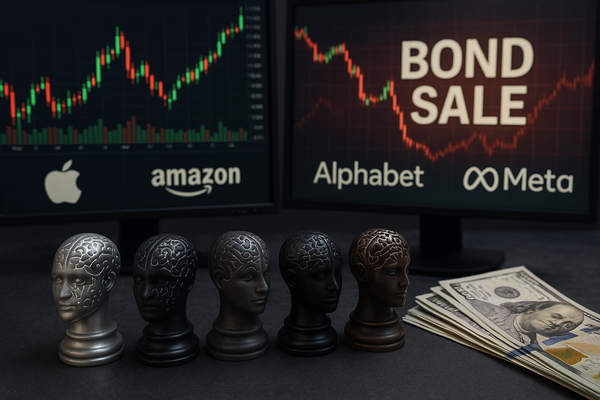
Big Tech earnings reshape the AI race. Apple (NASDAQ:AAPL) and Amazon (NASDAQ:AMZN) posted strong quarters while Alphabet (NASDAQ:GOOG) cleared the $100bn revenue mark. Meanwhile META (NASDAQ:META) stunned markets with a one‑time tax hit and a jumbo bond sale to fund a stepped‑up AI push. The near‑term story is market volatility as investors price bigger capex and financing plans. The long view: firms are locking capacity and talent for multi‑year AI data‑center demand. Globally, cloud and chip supply chains — from the U.S. to South Korea and China — will feel the impact, and the Trump‑Xi truce only partially eases tariff and rare‑earth uncertainty.
Quarterly beats meet an AI arms race
Apple’s third quarter results — revenue of about $102.5 billion and adjusted EPS of $1.85 — underscored resilient device demand, led by early strength for the iPhone 17. Analysts had feared a China slowdown; instead AAPL’s mix and services showed breadth. Amazon’s Q3 report confirmed a surge in cloud demand: AMZN delivered $180.2 billion in sales and EPS of $1.95, with AWS growth accelerating as customers buy more AI services.
Alphabet’s cloud and ad engine pushed the company past a $100 billion quarter, highlighting that search and YouTube remain major AI monetisation engines. Those three results offered a counterpoint to Meta (NASDAQ:META), which reported solid sales but flagged a nearly $16 billion tax charge and an aggressive capex roadmap. META is now raising financing: a record bond marketing that aimed to pull in $25–30 billion before pricing — a move investors saw as a concrete signal the cost of running frontier models is rising fast.
Why the financing and capex race matters now
Big Tech has shifted from proof‑of‑concept to industrialising AI. That requires huge data‑center capacity, GPUs and power — and that means near‑term cash needs and multi‑year commitments. Microsoft (NASDAQ:MSFT) disclosed a multibillion AI build that also spooked investors; reports put some recent AI‑related capex figures in the tens of billions. Nvidia (NASDAQ:NVDA) remains central as the primary GPU supplier and the market’s valuation barometer for AI hardware demand.
Short term, markets are reacting to capital intensity: META’s bond approach and guidance lifted questions about margins and near‑term returns. Over the long run, companies that secure capacity and favourable power deals — and manage supply‑chain exposure to tariffs and rare earths — could shape competitive moats in cloud and AI services. The Trump‑Xi meeting reduced some tariff noise, but trade policy and export controls remain part of the backdrop for hardware supply and cross‑border data strategies.
Device demand vs. cloud strength — two parallel growth engines
Apple is betting that product cycles and services can sustain growth without matching every AI play in smartphones. Tim Cook’s messaging after the print emphasised iPhone upgrades and a strong holiday quarter pipeline. That helped AAPL shares push close to record highs as investors priced a resilient consumer base and services leverage.
By contrast, Amazon’s stock rallied after AWS results confirmed enterprise customers are paying up for AI infrastructure. AMZN’s mix — e‑commerce plus a profit‑dense cloud — gives it both short‑term revenue resilience and the cash flow to fund capex. Alphabet is combining ad dollars and cloud backlog to fund its AI investments without the same degree of market jitters.
Sector watch: pharma, semiconductors and the wider market ripple
The quarter’s theme rippled beyond Big Tech. Chipmakers and memory suppliers are benefitting from the AI data‑center surge; NVDA’s ecosystem continues to dominate GPU conversations. On the healthcare front, Eli Lilly (NYSE:LLY) delivered an outsized beat as obesity and diabetes drugs continued to surge — a reminder that not all market leadership this season is tech‑centric.
At the macro level, markets are parsing Federal Reserve signals and the diplomatic easing between the U.S. and China. The truce calmed some fears about immediate tariff escalations and rare‑earth export controls. Yet policy details matter for semiconductor exports and advanced manufacturing relocation, which in turn affect capital plans across the tech stack.
What to watch next
Earnings and capex updates will remain the proximate drivers. Investors and industry watchers should track: 1) follow‑through guidance on 2026 capex from META and its peers; 2) GPU supply and pricing signals from NVDA and memory suppliers; 3) holiday‑quarter product demand and services growth from AAPL; and 4) cloud backlog and enterprise AI deals at AMZN and GOOG. Regulatory or trade announcements that shift export controls or tariffs would immediately reprice hardware availability and regional build‑out plans.
In short, this quarter marks a shift from AI competition fought in labs to a capital‑intensive infrastructure race. Companies that balance investment pace with financing and supply‑chain resilience will shape the next phase of enterprise AI adoption — and markets will watch every update closely.












